Schleswig-Holstein
![]()
The title of this article is ambiguous. For other meanings, see Schleswig-Holstein (disambiguation).
Schleswig-Holstein (officially: Land Schleswig-Holstein) /ˈʃleːsvɪç ˈhɔlʃtaɪ̯n/ (Low German Sleswig-Holsteen, Danish Slesvig-Holsten, North Frisian Slaswik-Holstiinj, abbreviation SH) is a parliamentary republic and a partly sovereign constituent state (Land) of the Federal Republic of Germany. The state capital and largest city of the state is the major city of Kiel; other major centres are the major city of Lübeck and the medium-sized cities of Flensburg and Neumünster. These four cities are district-free. The fifth largest city Norderstedt, which was formed in 1970 by a merger, has about the same number of inhabitants as Neumünster, but because of its proximity to Hamburg it is only considered a medium-sized centre in the conurbation.
The state between the North Sea and the Baltic Sea is the second smallest German state after Saarland. With an area of around 15,800 km², Schleswig-Holstein occupies 12th place among the 16 German states and ranks 9th in terms of population with around 2.9 million.
Today's state emerged on 23 August 1946, shortly after the Second World War, from the province of Schleswig-Holstein in the Free State of Prussia. It borders the Danish region of Syddanmark to the north, the Danish region of Sjælland across a maritime border in the Fehmarn Belt, the state of Lower Saxony and the Free and Hanseatic City of Hamburg to the south, and the state of Mecklenburg-Western Pomerania to the southeast.
Geography
Geographically, Schleswig-Holstein consists of the southern area of the Kimbrian Peninsula (Jutland) and part of the North German Plain. It is enclosed between the North Sea in the west, the Baltic Sea and Mecklenburg-Vorpommern in the east, Hamburg and Lower Saxony in the south and Denmark in the north. The small town of Nortorf is the geographical centre of Schleswig-Holstein.
Historically, today's Schleswig-Holstein consists of the southern part of the Duchy of Schleswig, the Hanseatic City of Lübeck and the two Duchies of Holstein and Lauenburg. The rivers Eider and Levensau marked the border between the Duchies of Schleswig and Holstein and were also the northern border of the Holy Roman Empire and the German Confederation respectively until 1806 and 1864 (German-Danish War). After the Prussian province of Schleswig-Holstein was formed from the two duchies of Schleswig and Holstein, the duchy of Lauenburg was annexed as a district in 1876. With the "Law on Greater Hamburg and Other Territorial Adjustments" (Greater Hamburg Law), the Lübeck district (Eutin district) of the Free State of Oldenburg, the Hanseatic City of Lübeck and the former Hamburg exclaves of Geesthacht, Großhansdorf and Schmalenbeck were annexed to Schleswig-Holstein in 1937. In exchange, the Holstein cities of Altona (until then the largest city in the state) and Wandsbek as well as several rural communities, including Blankenese, went to Hamburg.
Natural areas
The landscape of Schleswig-Holstein is divided from west to east into the Marsch, the high and low Geest and the Schleswig-Holstein Hills (also called the Eastern Hills). This landscape and also the Geest were formed in the last ice age as an end moraine landscape. Further to the east is the island of Fehmarn, which also belongs to the state and was also formed as a ground moraine during the last ice age. The largest river in the state is the Eider, the highest elevation is the Bungsberg (168 m).
The west coast is characterised by the Wadden Sea, whereby in the northern part (North Frisia) numerous Halligen are offshore in addition to the North Frisian Islands. The Eiderstedt peninsula juts further into the sea. The landscape names of the Wiedingharde and the Bökingharde were last (until 2007) only preserved as the names of two offices. South of it, and already partly in the area of the Geest lying, is between the river courses Soholmer Au and Arlau the Nordergoesharde, as well as between the latter and Husumer Mühlenau the Südergoesharde. The latter is mostly (except for the Hattstedtermarsch) a Geestlandschaft. The island of Helgoland, located further west in the German Bight as part of the North Sea, also belongs to Schleswig-Holstein.
South of North Frisia, between the Eider and Elbe estuaries, lies the Dithmarschen landscape, which is made up of the areas of Norderdithmarschen and Süderdithmarschen. This is followed by the Elbe marshes with the Wilstermarsch and the Kremper Marsch.
The east coast, which is also very fertile, is divided by fjords and bays into the hilly peninsulas of Angeln, Schwansen, Dänischer Wohld and Wagrien. The landscape around the large Holstein lakes is called Holstein Switzerland. The landscape of the Hüttener Berge lies inland on the border to the Geest.
The Geest itself could only be developed late due to the unsuitable soils for agriculture - even the attempts of heath and moor colonization in the 18th century can still be considered as failed. The traditional landscapes here are correspondingly sparse. The Schleswigsche Geest on the isthmus between the Schlei and the Eider, which was important for traffic early on, with the already mentioned Südergoesharde and the Stapelholm landscape are particularly worthy of mention. Near Neumünster lies the nature park Aukrug and east of Hamburg the landscape Stormarn, whose eastern part forms today the district Stormarn. In relation to the other states, Schleswig-Holstein is sparsely forested, with forests here covering only about ten percent of the state's area.
Regions
- Fishing
- Bökingharde
- Danish Welfare
- Dithmarschen
- Eiderstedt
- County Rantzau
- Haseldorfer Marsh
- Holstein Switzerland
- Hüttener Berge
- Duchy of Lauenburg
- Krempermarsch
- Luus Fishing
- North Frisia
- Probstei
- Schleswig Geest
- Swansen
- Steinburg
- Stapelholm
- Stormarn
- Wagrien
- Middle Holstein
- Wiedingharde
- Wilstermarsch
Nature and landscape conservation
The state is home to the Schleswig-Holstein Wadden Sea National Park, the largest national park in Central Europe, part of which is also designated as a biosphere reserve. In addition, with the nature reserves "Hohes Elbufer zwischen Tesperhude und Lauenburg" and "Lauenburger Elbvorland" as core areas, an - albeit small - part of the Elbe River Landscape Biosphere Reserve is located in Schleswig-Holstein.
In total, 189 nature reserves and 275 landscape conservation areas have been designated by state ordinances over the last 80 years. Excluding the national park, the areas cover 2000 km², of which about 1600 km² are marine or mudflat areas. Nature conservation associations often manage the areas on the basis of a contract with the state. In addition, there are six nature parks: Schlei Nature Park, Hüttener Berge Nature Park, Westensee Nature Park, Aukrug Nature Park, Holsteinische Schweiz Nature Park and Lauenburgische Seen Nature Park. None includes marine or coastal areas. The Schaalsee Biosphere Reserve directly adjoins the Lauenburg Lakes Nature Park in Mecklenburg-Western Pomerania.
A special feature is the Haseldorf Grey Heron Colony, a species protection area in Haseldorf, Pinneberg district. It is the largest and one of the most important breeding colonies of the grey heron in Schleswig-Holstein.
See also
List of water bodies in Schleswig-Holstein
List of surveys in Schleswig-Holstein
List of natural monuments in Schleswig-Holstein
List of protected landscape areas in Schleswig-Holstein
List of nature reserves in Schleswig-Holstein
List of natural units in Schleswig-Holstein
List of nature discovery areas in Schleswig-Holstein
List of geotopes in Schleswig-Holstein
State Commissioner for Nature Conservation in Schleswig-Holstein
· 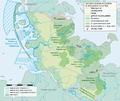
National and nature parks
·
Land reclamation in Beltringharder Koog
· 
March on Eiderstedt
· 
East Holstein Hilly Country
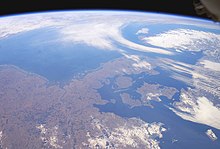
Schleswig-Holstein from space
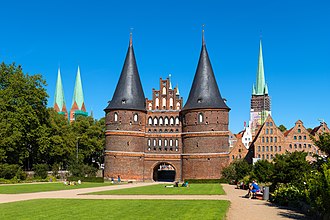
Lübeck always played a special role in Schleswig-Holstein. The actual hinterland was Mecklenburg. Nevertheless, the Holsten Gate is perceived by many as a landmark of the country.

A symbol of Schleswig-Holstein: Lighthouse Westerheversand
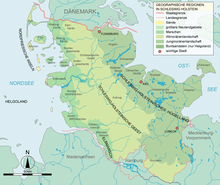
Natural landscapes in Schleswig-Holstein
Population
Demographics
| Total fertility rate | |
| 2000 | 1,43 |
| 2005 | 1,37 |
| 2010 | 1,45 |
| 2015 | 1,51 |
| 2018 | 1,58 |
Schleswig-Holstein has 2.9 million inhabitants, the population density of 183 inhabitants/km² is about one fifth below the national average (as of December 2019). Age structure and gender distribution largely correspond to the nationwide ratios.
Of the women, 45.7% are married, 12.9% widowed and 6.4% divorced. For men, the figures are 47.7%, 2.6% and 5.4% respectively. The population is unevenly distributed geographically. In addition to the independent cities, the Hamburg hinterland, especially the districts of Pinneberg and Stormarn, is densely populated, while the Schleswig district and the district of Dithmarschen are comparatively sparsely populated.
In terms of area and population, Schleswig-Holstein has some superlatives. For example, the state is represented 9 times in the list of the smallest municipalities in Germany in terms of area, e.g. with the second smallest municipality Arnis. In the list of the smallest municipalities in Germany by population 25 times, e.g. with the smallest municipality Gröde and the municipality Wiedenborstel, which has the lowest population density of all German municipalities. Schleswig-Holstein is characterised by a large number of small municipalities. The largest municipality in Schleswig-Holstein by area is the Hanseatic city of Lübeck, which was a free imperial city for many years. In contrast, Arnis is the smallest town in Germany, both by population and area. In the list of the smallest cities in Germany, Schleswig-Holstein is represented 17 times, although Schleswig-Holstein is home to only 63 cities. The four cities with the smallest area in Germany are in Schleswig-Holstein alone, and five others up to 16th place.
The average life expectancy in 2015/17 was 78.1 years for men and 82.8 years for women. Men thus rank 6th among the German federal states, while women rank 11th.
Ethnicities
Original resident population
The historically ancestral population is of (Lower) Saxon, Anglo, Jutish, Frisian and Slavic origin. Until the migration of the peoples, northern Schleswig-Holstein was still populated by the Angles. The landscape name Angeln still testifies to this today. The Angels who emigrated from Angles to Great Britain gave its name to England. In the Viking Age, Danes settled in central and eastern Schleswig, Frisians in western Schleswig, Saxons in central and southwestern Holstein, and the Slavic tribes of the Wagrians and Polabians in eastern Holstein and Lauenburg.
Traditional minorities
Schleswig-Holstein is home to a Danish minority (originating in the Schleswig region, now also in Holstein), a Frisian minority (on the North Frisian coast and on the islands) and a traditional minority of Sinti and Roma (mainly in the major cities of Kiel and Lübeck and in the Hamburg hinterland). These minorities are under special protection of the Schleswig-Holstein state constitution according to Art. 6; their minority languages, like Low German, are under protection according to the European Charter for Regional and Minority Languages (see also: Languages and dialects in Schleswig-Holstein).
Refugees and displaced persons of German origin
→ Main article: Refugees in Schleswig-Holstein after the Second World War
In relation to its own population, Schleswig-Holstein took in the most refugees and displaced persons of all the West German states during and after the Second World War. These came predominantly from Hinterpommern and East Prussia. Thus the population grew by 1.1 million between 1944 and 1949. The integration of the refugees was marked by conflicts, especially in rural regions.
foreign immigration
Due to its geographically isolated location and rather weak economic development, Schleswig-Holstein has the lowest proportion of foreigners among the West German Länder. (1999: 5,1 %). Of the 140,000 foreigners living here, a good three quarters come from Europe, with 22 % of the total foreigners coming from the old countries of the European Union. The largest group of all foreigners in 2012 came from Turkey with 30,000 persons, the second largest from Poland with 15,400.
Languages
→ Main article: Languages and dialects in Schleswig-Holstein and List of Schleswigian place names.
According to the wording of Section 82a I of the Schleswig-Holstein State Administration Act of 1992 (LVwG SH), last amended on 30 June 2016, "German" is the official language in the northernmost federal state, although it is legally unclear whether this refers only to High German or also to Low German.
Partially (spatially and/or factually), the regional and minority languages Low German, Danish and North Frisian have the status of approved official languages in Schleswig-Holstein in addition to High German: via the now clarifying regulation of § 82 b LVwG SH, these languages are also expressly approved as official languages in addition to High German; a similar regulation exists for North Frisian in § 1 of the Frisian Act. For Low German, the area of application is already state-wide according to the previous legal interpretation in the state and now also according to § 82 b LVwG SH, for Danish, the status according to this norm applies in Flensburg and the districts of North Frisia, Schleswig-Flensburg and Rendsburg-Eckernförde, for Frisian in the district of North Frisia and on Helgoland.
Low German, usually referred to as Plattdeutsch, is also recognised under the European Charter for Regional or Minority Languages as a regional language under Part III of the Charter, Danish (usually in the form of Sydslesvigdansk) and North Frisian (in its dialects) as minority languages under Part III, and Romany as a minority language under Part II of the Charter in the Land of Schleswig-Holstein.
In communities near the border between Niebüll and Flensburg, South Jutish (Plattdänisch) is also spoken, which is generally regarded as a dialect of Danish, as well as Petuh in the Flensburg area and Missingsch in some places. This makes Schleswig-Holstein the state with the most traditionally spoken languages. On the other hand, the Dutch language, once spoken in Friedrichstadt, and Yiddish, which was spoken in some towns until the time of National Socialism, are considered to be extinct; it is not known how high the proportion of Yiddish speakers is among the almost 2,000 inhabitants of Jewish faith who live there again today.
Proportions of languages: German about 2.7 million inhabitants, Low German about 1.3 million, Danish (Standard Danish, Sydslesvigdansk and Sønderjysk) about 65,000, North Frisian about 10,000, Romani about 5000.
In the district of Nordfriesland there are also bilingual place name signs in High German/North Frisian; for example, visitors to Niebüll are also announced the town as Naibel. In other municipalities in the state there are bilingual town entrance signs in the combination of High German/Low German, for example Eckernförde/Eckernföör.
The southeast of the country was populated by Slavic peoples until the 12th century, which can still be seen today in some place names of Slavic origin (for example Lübeck, Laboe, Eutin, Preetz, Ratzeburg).
Religions
Confession statistics
According to the 2011 Census, 51.5% of residents were Protestant, 6.0% were Roman Catholic, and 42.5% were non-denominational, belonged to another denomination, or did not specify. The sharp decrease in the number of Protestants contrasts with a very slight increase in the number of Catholics. At the end of 2019, Schleswig-Holstein had 2,903,722 inhabitants of which 43.3% were Protestant, 6.0% Catholic and 50.7% had either another religious affiliation or no religious affiliation at all. In the previous year, the two largest denominations still had a majority (44.6 % of the population were members of the Protestant churches, 6.1 % were members of the Roman Catholic church).
Detailed figures on other religious communities in Schleswig-Holstein (in addition to the Protestant and Roman Catholic churches) were last collected in the 2011 census. At that time, 0.9 % were members of a Protestant free church, 0.7 % professed a Christian Orthodox denomination, less than 0.1 % were of the Jewish faith and a further 1.8 % belonged to other religious communities recognised under public law in Schleswig-Holstein (this mainly includes special Christian communities such as Jehovah's Witnesses). Figures on the proportion of the population with a Muslim faith are not available from the 2011 census. A study by the BIM of the Humboldt University of Berlin from 2016 estimates the proportion of Muslims in the population of Schleswig-Holstein at around 3 %.
Christianity
Schleswig-Holstein is a Protestant state.
Evangelical Lutheran Churches
Since 27 May 2012, the Evangelical Lutheran Regional Church has been the Evangelical Lutheran Church in Northern Germany, or "Nordkirche" for short. It emerged from the Nordelbische Kirche, the Evangelical Lutheran Church of Mecklenburg and the Pomeranian Evangelical Church after a lengthy merger process that resulted in a merger agreement signed on 5 February 2009. In the area of Schleswig-Holstein, there are two dioceses: Schleswig and Holstein, and Hamburg and Lübeck, each headed by a bishop. The North Elbian Church was also already a merger founded in 1977, in which the three Evangelical Lutheran regional churches in Schleswig-Holstein had merged until then.
In addition to the North German regional church, there are also congregations in Schleswig-Holstein of the old denominationally constituted Independent Evangelical Lutheran Church and, in the north of the country, of the Danish Church in Southern Schleswig. The Danish Church in Southern Schleswig has about 6300 members (as of 1 January 2012).
Catholic Churches
The parishes of the Roman Catholic Church in Schleswig-Holstein are under the jurisdiction of the Archbishopric of Hamburg. In addition to the Roman Catholic Church, there is also an Old Catholic parish on the North Frisian island of Nordstrand. The Roman Catholic Church is growing, 6.1% of the population is Roman Catholic in 2018, a year earlier 5.8% were Roman Catholic.
Evangelical Free Churches
Among the Protestant free churches represented in Schleswig-Holstein are Evangelical Free Churches (Baptists), Methodists, Mennonites, Free Evangelical Churches, the Salvation Army, the Remonstrants, Seventh-day Adventists and several Pentecostal churches. Already in the 16th century there were first Anabaptist congregations on Eiderstedt. The first Baptist congregation in Schleswig-Holstein was founded in February 1849 in Pinneberg, Holstein.
According to the 2011 census, the Protestant free churches had about 25,000 members at that time. The Protestant Reformed Church is represented by a congregation in Lübeck, while the Hamburg congregation also has many members in Schleswig-Holstein. The Remonstrants are represented by a congregation in Friedrichstadt.
New Apostolic Church
In the New Apostolic Church, Schleswig-Holstein is part of the Apostle district of Hamburg and comprises five districts with around 10,000 members on the territory of Schleswig-Holstein.
Judaism
About 1900 inhabitants of the state are members of Jewish communities. The Jewish communities are divided into two state associations: the more orthodox Jewish Community of Schleswig-Holstein and the more liberal State Association of Jewish Communities of Schleswig-Holstein. The Goethestraße synagogue in Kiel was destroyed during the Night of Broken Glass. Today there are three active synagogues in Schleswig-Holstein, in Lübeck, Bad Segeberg and Kiel.
See also:
- List of synagogues in Germany#Schleswig-Holstein
- List of old synagogues in Schleswig-Holstein
Islam
85,000 people are said to profess Islam in Schleswig-Holstein. The largest mosque in the state is the Centrum Mosque in Rendsburg. There are over 60 mosques in Schleswig-Holstein.
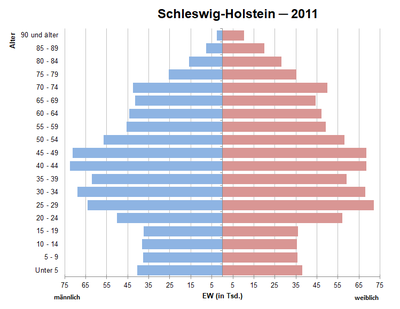
Population pyramid for Schleswig-Holstein (data source: Census 2011)
Questions and Answers
Q: What is Schleswig-Holstein?
A: Schleswig-Holstein is a state in Germany, bordering Denmark in the North, the North Sea in the West, the Baltic Sea and Mecklenburg-Western Pomerania in the East, and Lower Saxony and Hamburg in the South.
Q: What are the different names for Schleswig-Holstein in different languages?
A: Schleswig-Holstein is known as Slesvig-Holsten in Danish, Sleeswiek-Holstain in Low Saxon, Sleeswyk-Holstein in Frisian, and Schleswig-Holstian in North Frisian.
Q: How many independent towns are there in Schleswig-Holstein?
A: There are 4 independent towns in Schleswig-Holstein.
Q: What is the capital of Schleswig-Holstein?
A: Kiel is the capital of Schleswig-Holstein.
Q: Which direction does Schleswig-Holstein border Denmark?
A: Schleswig-Holstein borders Denmark in the North.
Q: Which bodies of water border Schleswig-Holstein?
A: Schleswig-Holstein is bordered by the North Sea in the West and the Baltic Sea in the East.
Q: Which other German states border Schleswig-Holstein?
A: Schleswig-Holstein is bordered by Mecklenburg-Western Pomerania and Lower Saxony to the East and South, and Hamburg to the South.
Search within the encyclopedia
